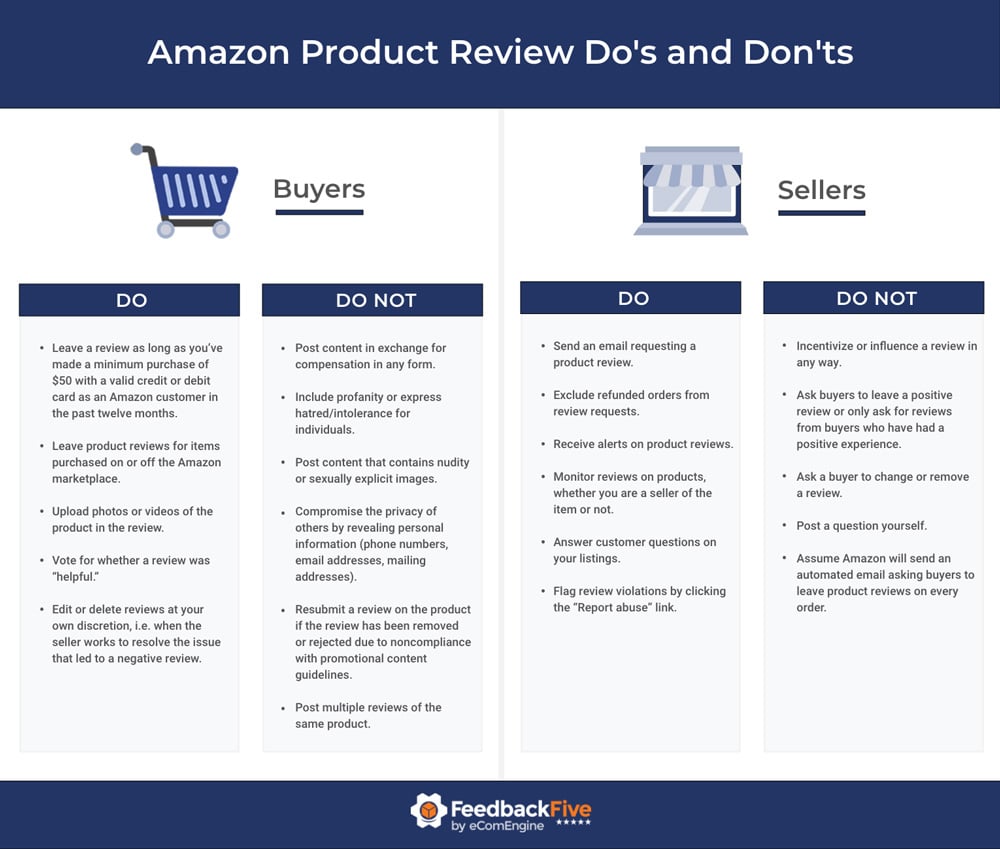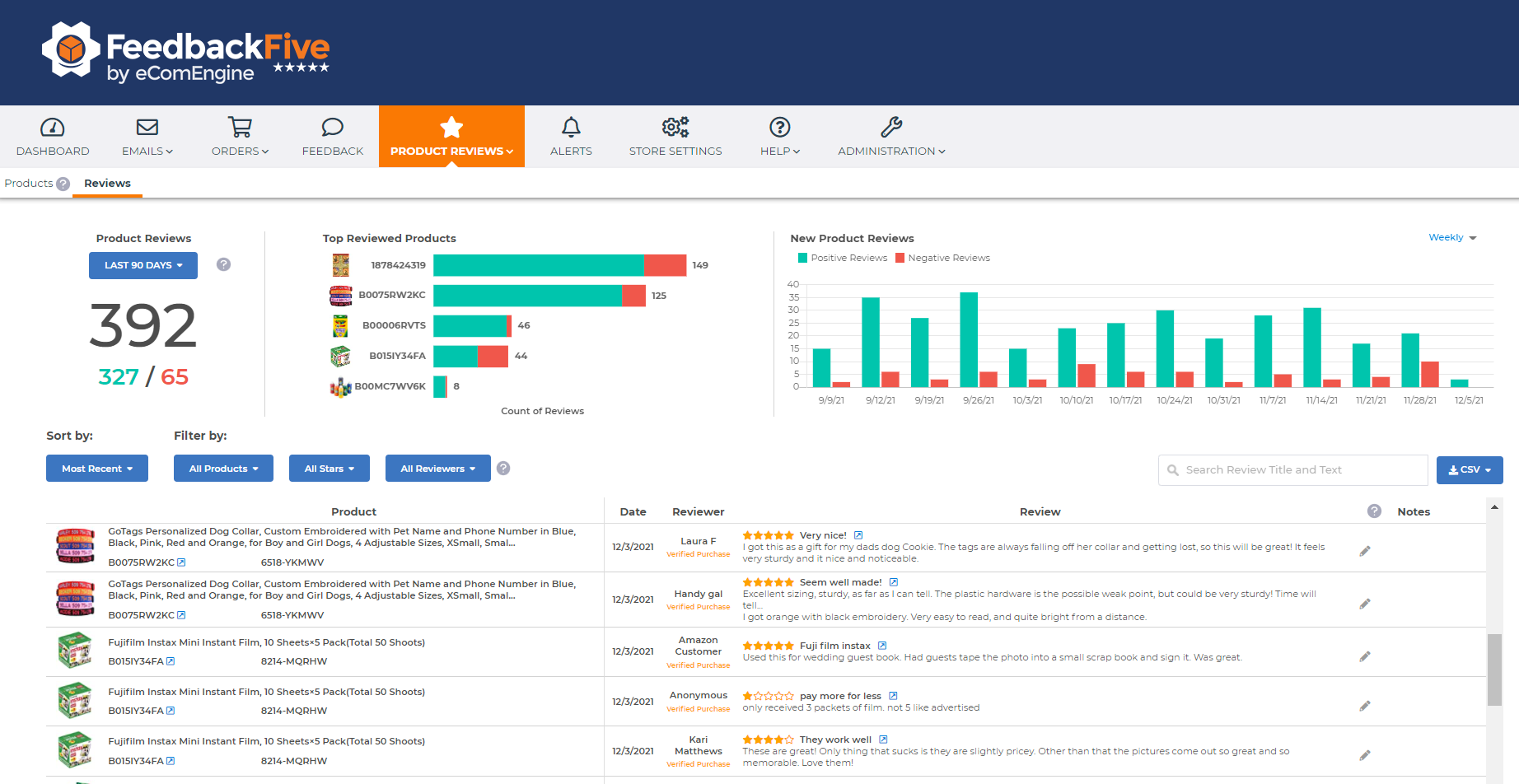Originally published on June 12, 2018, updated July 23, 2024
Menu
Join Our Email List
- Receive our monthly newsletter.
- Stay up to date on Amazon policies.
- Get tips to grow your business.
When the Amazon marketplace launched in 1995, online reviews were very uncommon. Many people thought that allowing customers to leave reviews was a crazy idea. But this customer-centric practice is one of the differentiators that has helped Amazon grow into one of the world’s top companies.
Online product reviews can significantly impact sales conversions. A study showed that 88% of consumers trust online reviews as much as personal recommendations. In other words, product reviews can mean the difference between hitting a plateau and continuing to grow your eCommerce business.
In this guide, we’ll share an overview of the Amazon review guidelines for both buyers and sellers as well as best practices for requesting and monitoring product reviews.
The best way to get more reviews for your products is to ask for them, but there are a few things to keep in mind when doing so.
Staying compliant with Amazon review guidelines is crucial for keeping your account in good standing. Do not attempt to influence a review in any way. This means you shouldn't ask buyers to leave a positive rating or only ask for reviews from buyers you know had a positive experience. You cannot ask a buyer to change or remove a review, even if you resolve their issue.
Amazon banned incentivized reviews in October 2016. Today, merchants are not allowed to offer any form of compensation in exchange for a review. This includes money, gift cards, free products, discounts, refunds, reimbursements, and any other future benefits. While fake reviews are still alive and well on the Amazon marketplace, the measures Amazon has taken to stop bad actors mean that attempts to manipulate customer reviews are taken seriously and could lead to major consequences for your seller account.

You, your relatives, business associates, or close friends should never attempt to create/modify/post content on Amazon regarding your products or services or a competitor’s products or services. That includes leaving reviews, whether positive or negative.
You can ask buyers to provide a review of your product. However, your message must be sent within 30 days of order completion. It also needs to include the 17-digit order ID and be in the buyer's preferred language. (Software like FeedbackFive by eComEngine makes following these Amazon review guidelines easy!)
You should answer questions asked in Customer questions and answers. You may not post a question yourself. When answering a question, you should state your connection to the product unless Amazon automatically labels you as a seller or manufacturer.
If you receive a review that violates an Amazon Community Guideline, you can flag it for Amazon’s review by clicking the “Report abuse” link near the post and entering the reason you feel that it violates the Community Guidelines.
When providing a product rating, customers select a star rating between 1-5 stars, with 5 being the best. They can choose to only leave a star rating or provide more details about their experience with the product by adding a short headline and a written review. They can also rate features such as "value for money" on the same star scale.
Customers can upload photos or videos of the product in the review. When the published review is displayed on the Amazon website, it shows the date the review was written as well as the product variation reviewed. Reviews are searchable and shoppers can vote for whether a review was helpful by clicking the "helpful" button below each review.
Amazon customers can leave product reviews for items purchased on or off the marketplace. This means that your listings could receive reviews from individuals who did not purchase an item from you. If a buyer has purchased the product from the Amazon marketplace, a “Verified Purchase” badge will be displayed on the review.
Amazon encourages customers to leave genuine ratings of products and services. Repetitive text, spam, or pictures created with symbols are not allowed.
To help encourage authentic reviews, reviewers are required to have made a minimum purchase of $50 with a valid credit or debit card as an Amazon customer in the past twelve months. They are also asked to adhere to Amazon’s Community Guidelines when writing reviews. We recommend reading the guidelines in full, but to familiarize you with them here are the basics:
Again, these are the Amazon review guidelines for buyers who write reviews, answer customer questions, or provide other content on the site.
Amazon does not typically delete product reviews. There are only three reasons that a review may be removed from the Amazon site:
It’s worth noting that Amazon will not remove reviews that compare your product with other products or make your listing look bad if the reviews are within the Community Guidelines. You cannot block buyers who leave bad reviews for your products unless they violate those standards.
As a seller or brand owner, you can learn a lot by monitoring product reviews – both your own and those of products you’re interested in selling. For example, if your product is consistently getting negative reviews, maybe the SKU is defective.
Paying attention to product reviews can alert you to issues, giving you data that empowers you to act. If you notice a trend in your reviews, it's worth digging in.
For example, if you receive several reviews that comment that the item is not the expected color, you’ll want to update your listing to ensure that you are setting the right expectation for future buyers. Sometimes you simply need to update your listing with new information, while other times you might need to address a product defect with your manufacturer. Either way, your reviews help you quickly identify circumstances where you're not meeting the buyer's expectations for your product.
Keeping tabs on products you’re thinking about selling or on competitor items can help you get a feel for market perception. Are the reviews generally positive? Do existing customer reviews spark any ideas for you to make your product better than those already on the market?
You can monitor your ASINs as well as competitor ASINs with FeedbackFive. Review analytics and alerts make it easy to spot trends.
Looking at product reviews regularly is an excellent way to stay informed about the customer experience. Understanding how customers perceive your product can help you refine your listing content and provide the details buyers need. For example, if you notice multiple negative reviews related to the item not appearing as described, you can add more detailed information about the item's appearance to your listing and update your product images.
Negative reviews can alert you to possible product improvements and provide ideas for bundling opportunities and other ways to make the listing stand out. They can also highlight new ways to use existing features; buyers are creative! We’ve heard from several sellers who say their customers have given them fresh ideas for product use cases through reviews.
The best way to get more product reviews is to ask for them! Amazon occasionally sends automated emails asking buyers to leave product reviews, but you have no control over when these messages are sent. You need to proactively request reviews.
FeedbackFive makes it easy to send automated review requests that are always compliant with Amazon review guidelines by using the Amazon Request a Review button, just like this seller did to great success.
Want to learn even more about getting reviews? Check out the Seller's Guide to Getting More Amazon Reviews!
Amazon does not send notifications when your products get new reviews, so you need to monitor them manually or use a third-party tool to facilitate review monitoring.
Many sellers choose to track and monitor their ASINs with FeedbackFive, which provides optional SMS or email alerts when new positive or negative feedback or reviews are received.

It’s also easy to analyze trends and see how a product performs over time with detailed product review analytics. You can filter your reviews and even export them into a CSV format.
You can also see how your requests impacted the written reviews and ratings you received with Campaign Analytics.

See the number of emails you've sent, orders received, and types of feedback and reviews received for a specified time frame with the Product Metrics Table.
As an Amazon seller, product reviews can take your business to the next level. Well-written reviews can significantly increase conversions and help your product rank higher in search results. Product reviews serve as a form of social proof for buyers who may be on the fence about a potential purchase.
Be sure to comply with all Amazon review guidelines when asking for reviews. The simplest and often most effective way to send review requests is by automating the Amazon Request a Review message. This allows you to stay compliant with all Amazon policies with ease.
Originally published on June 12, 2018, updated July 23, 2024
This post is accurate as of the date of publication. Some features and information may have changed due to product updates or Amazon policy changes.
These Stories on Feedback and Reviews
14321 Winter Breeze Drive
Suite 121 Midlothian, VA 23113
Call us: 800-757-6840





Copyright© 2007-2025 eComEngine, LLC. All Rights Reserved. eComEngine®, FeedbackFive®, RestockPro®, and SellerPulse® are trademarks or registered trademarks of eComEngine, LLC. Amazon's trademark is used under license from Amazon.com, Inc. or its affiliates.
Comments (3)